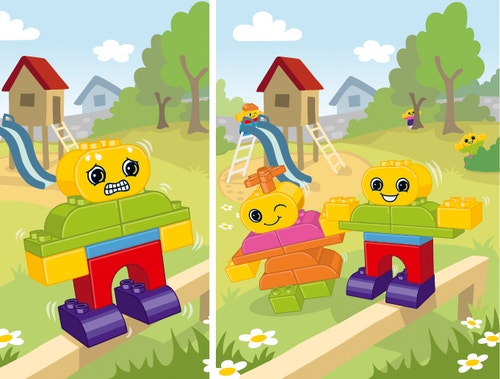Jayden Tries Something New
Understanding and learning about perseverance.

Connect
Snap your fingers and explain how hard it can be to learn to snap your fingers when you are young.
If applicable, share memories of when you finally learned to do it.
- Explain that it took time and practice.
- Share that some people could do it before you could and that some people didn’t learn to do it until after you did.
- Perhaps someone showed you how to put your fingers just right in order to be able to do it.
Explain that if you had given up, you would be a grown-up who couldn’t snap your fingers.
Ask the children to share with the person next to them something that was difficult for them to learn how to do.
Teacher tip: Use any personal example of fine or gross motor tasks to which young children might relate (e.g., blowing bubbles, holding a pencil properly, putting on coats/gloves, skipping, putting your face under water, etc.).
• Tell the children you will read them a story about Jayden.
• Explain that Jayden is trying to learn something new, but it is difficult for him.
• Show the children the illustration for this lesson.

Read the following story aloud:
Jayden took a deep breath and climbed onto the balance beam. He took one small step and started to wobble. He tried to take another step, but he fell off the side onto the ground.
Jayden climbed back onto the balance beam and stood with his toes pointing sideways instead of toward the end of the beam. He inched his left foot sideways, then he inched his right foot sideways. Jayden began to wobble again, then he fell forward onto the ground. Jayden sat on the grass. His lip began to quiver.
I’m not good at this. It’s too hard. He said to himself. Tears ran down Jayden’s cheeks.
A few moments later, Jeesun came over to the balance beam. She climbed on, held her arms straight out at her sides, and gracefully walked across the beam with one foot in front of the other.
Amazed, Jayden asked, “How did you do that?”
Jeesun answered, “I practiced a lot. And my dad helped me by holding my hand while I learned to balance.”
“Oh,” Jayden said as he looked down.
“I could help you,” Jeesun offered.
“Okay, I will give it another try,” Jayden said.
He climbed back onto the balance beam and held out his arms the way he had seen Jeesun hold hers. Jeesun held one of Jayden’s hands and helped him steady himself. Jayden took one step forward, and Jeesun walked alongside him. He wobbled less this time. He took another step, then another. Soon, he made it all the way to the end of the balance beam. Jayden felt very happy!
Consider asking questions like:
- At the beginning of the story, what was the problem?
- How did Jayden try to solve it himself?
- What happened to cause Jayden to get discouraged?
- What did Jayden think about while he was sitting on the grass?
- How was Jayden’s problem solved?
Construct
Tell the children to work with a building buddy to build a model showing one of the buddies struggling while they are trying something new.
Activity tip: If the children have difficulty thinking of what to build, give some examples (e.g., playing soccer, learning to swing, riding a scooter, learning to swim). Or simplify the challenge by asking the children to build Jayden on the balance beam.
Contemplate
Ask the children to share their models. Consider asking questions like:
- Why was this new task difficult?
- How did you feel while struggling?
- Did you keep trying, take a break, give up, or seek help?
- How did you feel after you did it?
Continue
Explain that obstacle courses are races made up of several tricky challenges for your body. They require strength and perseverance to finish.
Tell the children to work individually or with a building buddy to build an obstacle.
Combine all of the obstacles together to make an obstacle course for Jayden and Jeesun.
Ask each obstacle creator to explain how the obstacle should be run.
Ask the children to use models of Jeesun, Jayden, or other figures to “run” the obstacle course as the class cheers them on!
Did you notice?
Observing the following skills can help you monitor whether the children are developing socially and emotionally.
- Children are able to show confidence in taking on new tasks.
- Children are able to identify personal thoughts and feelings.
Ondersteuning voor de leraar
Children will :
Understand that it takes time to learn how to do something new.
Children are able to show confidence in taking on new tasks.
Children are able to identify personal thoughts and feelings.